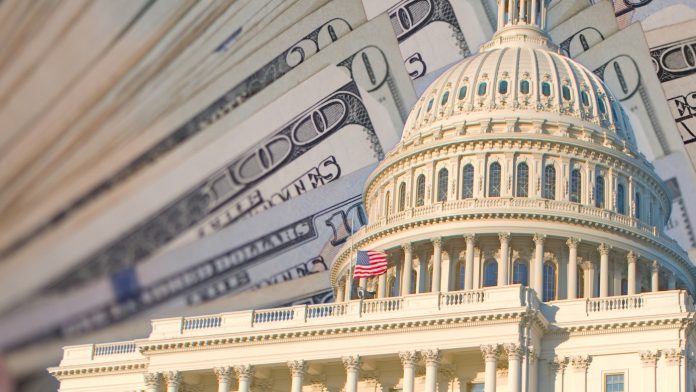Douglas Rissing/iStock/Getty Images Plus
This first appeared in the Planet Money newsletter. You can sign up here.
A constitutional conflict is brewing over Congress’ power of the purse and whether the president can refuse to spend what Congress has directed him to spend.
Since taking office, the current administration — along with Elon Musk’s Department of Government Efficiency (DOGE) — has been seeking to cut federal spending, reduce workforce levels and dismantle programs and bureaucracies without going through the legislative process. They’re instead claiming that the president has the power to unilaterally override the existing spending plans set by Congress.
The current administration’s broad assertion of executive power to slash spending is not completely out of the blue. Before taking office, President’s Office of Management and Budget (OMB) director — Project 2025 architect Russell Vought — and OMB general counsel Mark Paoletta were both very vocal that the president can and should take unilateral actions to cut spending. And in a Wall Street Journal opinion piece published in November, Musk and then DOGE co-leader Vivek Ramaswamy announced that DOGE “will focus particularly on driving change through executive action based on existing legislation rather than by passing new laws.”
Even more telling, in 2023, when he was running for reelection, the President released a campaign video in which he outlined his view that the president should have a special power to slash spending known as “impoundment,” or the power to refuse to spend money appropriated by Congress.
“For 200 years under our system of government, it was undisputed that the president had the constitutional power to stop unnecessary spending through what is known as impoundment,” the President said. “Very simply, this meant that if Congress provided more funding than was needed to run the government, the president could refuse to waste the extra funds.” Giving the president the power of impoundment, he said, would help him balance the budget, “drain the swamp” and “obliterate the deep state.”
In the President’s telling, presidents were allowed to freely wield impoundment power until 1974. That’s when the government, during the Watergate era, enacted the Impoundment Control Act, which restricts presidents from unilaterally impounding funds.
“This disaster of a law is clearly unconstitutional — a blatant violation of the separation of powers,” the President said.
However, a long line of legal scholars, officials and judges from both major political parties — including Brett Kavanaugh, who was appointed by the President to the Supreme Court — has rejected the idea that the president has a constitutional power to ignore spending laws. They say that the Constitution clearly gives Congress the power of the purse and that this includes the power to tell the executive branch how much — and how little — to spend on things (when those spending directives have passed both houses of Congress and been signed into law by a president, or when, in the face of a presidential veto, Congress passes the spending law with a supermajority in both chambers).
Today in the Planet Money newsletter, what is presidential impoundment power? Is it really constitutional? Or are we witnessing an unconstitutional power grab? We dive into the debate.
Trumpworld’s case for presidential impoundment
First up, let’s look at the current administration’s case that impoundment is an inherent power of the president that was unconstitutionally taken away.
Paoletta and his colleagues have made the most comprehensive case for this. Paoletta was the top lawyer at the OMB during the President’s first term and is now serving his second stint in that same position. So he’s not just some random academic.
Last year, Paoletta and his colleagues wrote some legal memos outlining their case for a presidential impoundment power (and also the case for why the Impoundment Control Act, which restricts the president from exercising this power unilaterally, is unconstitutional).
In their first memo, they dive into American history. “Since the Founding, Congress’s power of the purse has been understood to establish a ceiling on Executive spending, not a floor,” they write. “Until the Presidency of Richard Nixon, it was overwhelmingly understood that the power of the purse restricted only the President’s ability to spend more than an appropriation — it was not understood to prohibit the President from spending less than an appropriation.”
Paoletta and his colleagues claim that tons of presidents used impoundment power before the Nixon-era restrictions — and that everybody was fine with that. For example, they write that President Thomas Jefferson “refused to spend a congressional appropriation of $50,000 for 15 gunboats for use on the Mississippi.” Congress had passed a law funding these gunboats, but Jefferson ended up being like, “Nah, it’s cool. Don’t need it.” And Congress was like, “OK, no worries.”
President Ulysses S. Grant, Paoletta and his colleagues write, impounded some infrastructure funds for rivers and harbors. Grant objected to some of the spending because he viewed it as wasteful and not serving the national interest.




